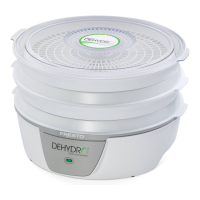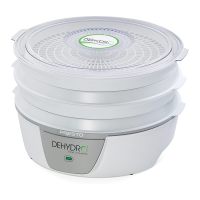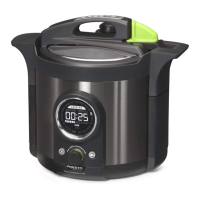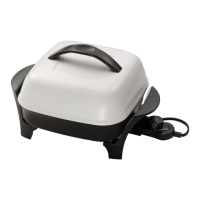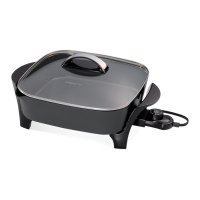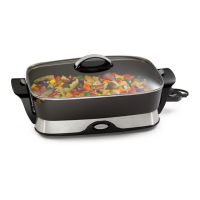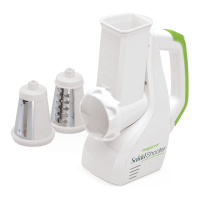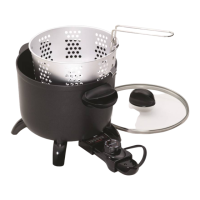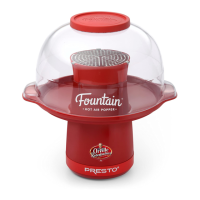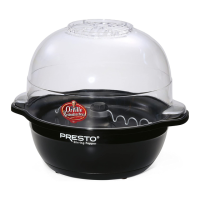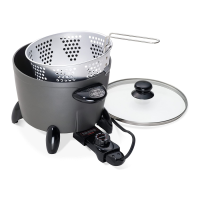3
• For the cover to t properly, the top tray must be one without handles.
• If you have only three trays of food to dehydrate, place an empty tray on the stack.
8. Unwind the cord from the cover and plug into a 120VAC electrical outlet only. To
operate properly, the dehydrator must have sufcient airow; therefore, be sure the
vents surrounding the cover are not obstructed at any time (Fig. C).
9. Place the cover over the stacked trays.
10. Begin dehydrating. See below for general dehydrating information and
pages 4 through 9 for information for specic foods.
11. When nished dehydrating, remove plug from wall outlet.
Care, Cleaning, and Storage
1. Wipe the power cover with a damp cloth. Do not immerse the power cover in water or other liquid.
2. Wash the dehydrator trays and base in warm water and a mild detergent. Do not wash these parts in the dishwasher. If necessary, a
soft brush may be used to loosen dried on food particles.
Do not use steel wool scouring pads or abrasive cleaners on any of the dehydrator parts.
3. For compact storage, stack the trays onto the base. Begin with a tray with handles and stack
it with the raised ribs facing up; the
handles should read “UP FOR STORAGE.” Place a tray without handles, smooth side up, on top of the rst tray with handles.
Alternate between trays until all of them are stacked on the base. Then place the power cover on top of the trays.
4. Wrap the cord around the cover, securing the cord in the clips (Fig. A, page 2).
General Dehydrating Information
• This dehydrator operates at a preset temperature of approximately 165°F.
• When selecting food for drying, choose those that are at peak eating quality. Avoid overripe** or immature fruits and vegetables.
Remove any parts of the food that are bruised or blemished.
• For even drying, cut food into uniform sizes, shapes, and thicknesses.
• Drying times are highly variable depending on the type and amount of food, thickness, evenness of food pieces, humidity, air
temperature, personal preference, and even the age of the plant at the time of harvesting. Therefore, throughout the book you will
notice that a range of average drying times is provided. You may need or prefer to dry your foods for shorter or longer periods
than those listed. For best results, begin checking your food at the beginning of the range listed in the instructions. You should
then gauge how often you should recheck the food based on how the drying is progressing. With some foods, such as jerky, that
may mean every 30 minutes, and with other foods, such as fruits, that may mean every 1 to 2 hours.
• Dehydration prevents microbial growth; however, chemical reactions caused by enzymes in fruits and vegetables can occur unless
the food is pretreated before drying. Although not required, pretreatment may prevent or minimize undesirable color and texture
changes during drying and storage. See specific sections for recommended pretreatment.
• Place foods in a single layer on the trays. Do not allow foods to touch or overlap.
• When drying strong-smelling foods, such as onions and garlic, be aware that there will be a strong odor during the drying process.
That odor may linger after drying has been completed.
• Individual pieces of food may not all dry at the same time. Foods that are appropriately dried should be removed before those that
still require additional drying. Always check all of the trays for foods that are appropriately dried. Allow dried pieces to cool
and then place in a covered container.
• If one tray of food is finished before the others, remove the dried food and return the empty tray to the unit rather than rearranging
the trays.
• Do not add undried food to a partially dried load. This will add moisture and increase the drying time.
• Allow for continuous drying. Do not unplug dehydrator in the middle of the drying cycle and resume drying at a later time as this
may result in poor quality and/or unsafe food.
• CAUTION! For food safety, wash hands thoroughly prior to preparing food for dehydrating. Likewise, thoroughly clean all uten-
sils, cutting boards, and surfaces that will be used for preparing food. Wash foods before preparing them for dehydrating.
**Slightly overripe fruits are acceptable for making fruit rolls.
Vents
Fig. C
